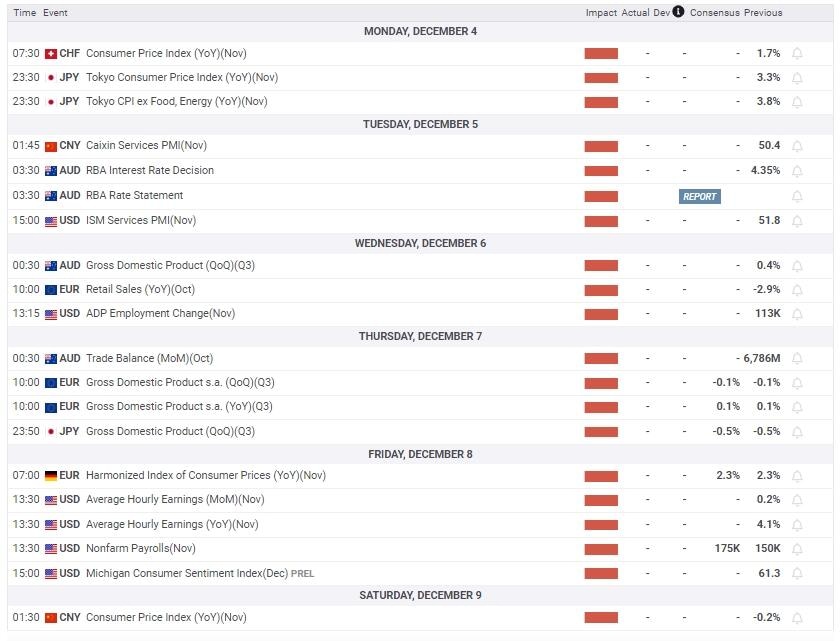Gold Price Weekly Forecast: XAU/USD looking at $2100 and US labor market data
- Gold remains near record highs and achieved its highest monthly close ever in November.
- Global bond yields continue to decline as inflation further cools, supporting the upside in XAU/USD.
- With central banks expected to remain on hold, the focus will be US labor market data.

Gold decisively broke above the $2,010 level and moved closer to the record high area, boosted by a decline in global government bond yields. Evidence that inflation continues to edge lower in Europe and the US solidifies expectations that the Federal Reserve (Fed), the European Central Bank (ECB), and other central banks are finished with interest rate hikes. This has also bolstered equity prices and kept the US Dollar under pressure. Next week's data, particularly US jobs figures, could challenge the current market sentiment, sparking a new debate.
Gold shines, inflation slows
Gold not only broke above $2,000 but also surpassed the significant $2,010 level, positioning itself to challenge record highs. In November, XAU/USD achieved its highest monthly close ever.
A key factor driving the increase in Gold prices was the decline in government bond yields worldwide. Data showed a slowdown in inflation in November in the US, Europe, and Australia at a faster-than-expected rate, to the envy of many Argentinians.
In Germany, the annual rate of the Consumer Price Index (CPI) stood at 3.2%, while in the Eurozone, it was at 2.4% (with core inflation at 3.6%). These figures are closer to the European Central Bank's (ECB) target and suggest that no further tightening would be necessary in the near future. With a gloomy economic outlook ahead, the debate is shifting towards when the ECB will cut rates. This expectation has pushed European yields lower.
While the European economy stagnates, the US continues to grow above trend. Market participants learned during the week that the US economy expanded at an annualized rate of 5.2% in the third quarter, higher than the previously reported 4.9%. This confirms that the US is still far from a soft landing. It does not imply that the Fed will raise rates further, but it leaves the door open for the central bank to do so if inflation rebounds.
However, some warning signs are emerging. The Beige Book signaled that "business activity continued to decline slightly" from early October to November 17. Continuing jobless claims resumed an upward trend, surging by 86,000 in the week ending November 18, reaching the highest level since November 2021.
Comments from Federal Reserve officials during the week varied. However, the overall tone remains that, for the time being, the Fed will maintain its policy unchanged, adhering to the "higher for longer" mantra. Doves mention that a sufficiently restrictive policy is in place, while hawks warn that they would support further rate hikes if "inflation progress stalls."
Lower yields, a depreciation of the US Dollar, and higher equity prices point to loosening financial conditions, which do not support the Fed's intentions. This adds more pressure on officials to avoid a dovish tone.
Focus on US jobs data
Next week, the Reserve Bank of Australia (RBA) will announce its decision on monetary policy with no expected change. The same applies to the Bank of Canada (BoC). Market participants won't be hearing from Federal Reserve officials as the central bank enters the blackout period ahead of the December 12-13 FOMC meeting.
The crucial economic figures will come from the US labor market. On Tuesday, the JOLTS Job Openings report will be released, followed by the ADP Private Employment Change on Wednesday, and weekly Jobless Claims on Thursday. And finally, the Nonfarm Payrolls report on Friday. These figures could have an impact on Gold.
Evidence of a more balanced job market will reinforce the notion that the Fed is done raising rates and could further boost the price of Gold towards record highs. Even numbers aligned with expectations could trigger more gains in XAU/USD. However, upbeat figures that show a still-tight labor market could strengthen the US Dollar and weigh on Gold.
The uptrend for XAU/USD is likely to remain in place as the market focuses on the Fed not raising rates further. If the focus changes to the US economy outperforming, then the US Dollar could start gaining momentum and potentially limit the upside in metals. Given the current level of Gold price, this could lead to an intense correction.
Gold technical outlook
The weekly chart shows that the upward trend in Gold is strong and points towards a test of record highs around the $2,085 area. A weekly close below $2,010 would suggest that XAU/USD is not yet ready for new historical levels. Technical indicators on the weekly chart are bullish. However, considering Gold's level, the upside is not risk-free and could be susceptible to sharp corrections.
A decline below $2,010 could extend to $1,975, with the next strong support at $1,930. On the upside, a consolidation above $2,050 would clear the way for a test of $2,080. A further breakout higher would shift the focus to $2,100.
Inflation FAQs
What is inflation?
Inflation measures the rise in the price of a representative basket of goods and services. Headline inflation is usually expressed as a percentage change on a month-on-month (MoM) and year-on-year (YoY) basis. Core inflation excludes more volatile elements such as food and fuel which can fluctuate because of geopolitical and seasonal factors. Core inflation is the figure economists focus on and is the level targeted by central banks, which are mandated to keep inflation at a manageable level, usually around 2%.
What is the Consumer Price Index (CPI)?
The Consumer Price Index (CPI) measures the change in prices of a basket of goods and services over a period of time. It is usually expressed as a percentage change on a month-on-month (MoM) and year-on-year (YoY) basis. Core CPI is the figure targeted by central banks as it excludes volatile food and fuel inputs. When Core CPI rises above 2% it usually results in higher interest rates and vice versa when it falls below 2%. Since higher interest rates are positive for a currency, higher inflation usually results in a stronger currency. The opposite is true when inflation falls.
What is the impact of inflation on foreign exchange?
Although it may seem counter-intuitive, high inflation in a country pushes up the value of its currency and vice versa for lower inflation. This is because the central bank will normally raise interest rates to combat the higher inflation, which attract more global capital inflows from investors looking for a lucrative place to park their money.
How does inflation influence the price of Gold?
Formerly, Gold was the asset investors turned to in times of high inflation because it preserved its value, and whilst investors will often still buy Gold for its safe-haven properties in times of extreme market turmoil, this is not the case most of the time. This is because when inflation is high, central banks will put up interest rates to combat it.
Higher interest rates are negative for Gold because they increase the opportunity-cost of holding Gold vis-a-vis an interest-bearing asset or placing the money in a cash deposit account. On the flipside, lower inflation tends to be positive for Gold as it brings interest rates down, making the bright metal a more viable investment alternative.
Premium
You have reached your limit of 3 free articles for this month.
Start your subscription and get access to all our original articles.
Author

Matías Salord
FXStreet
Matías started in financial markets in 2008, after graduating in Economics. He was trained in chart analysis and then became an educator. He also studied Journalism. He started writing analyses for specialized websites before joining FXStreet.

-638370435345474806.png&w=1536&q=95)

















